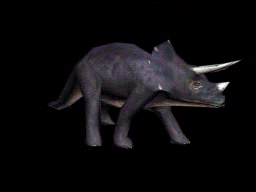|
|
|
"Triceratops"
Triceratops horridus

(Greek tri = "three" + Greek keratos = "horn" + Greek ops = "face") Size: 9 meters (30 feet) Period: Late Cretaceous (68 million to 65 million years ago)
Place: Colorado, Wyoming, Montana, South Dakota, Alberta The Triceratops' distinctive features were familiar to nearly all even before the opening of the park. A short horn on the nose is supplemented by two larger horns on the forehead, averaging some 3 feet in length. These massive creatures also wield one of nature's most formidable defense mechanisms, a 2.5 meter (7.5 feet) neck frill composed of a solid sheet of bone. Many of these neck frills possess barnacle-like knobs as well, adding further protection.
Environment: Creating a suitable habitat for the Triceratops has turned out to be more difficult than originally anticipated. The most successful colonies currently reside in the plains and semi-arid regions.
Feeding: Much of the difficulty in acclimating the Triceratops to the Jurassic Park environment is directly caused by the creature's specific food needs. While a strict herbivore, the Triceratops' elongated teeth, while extremely sharp, have proven to be less than suitable for chewing ordinary leafy plants. While palm fronds gathered by Rangers from the trees around Universal Studios Hollywood have sustained the creatures so far, there is much concern over finding a more consistent source of nutrition for these hearty eaters.
Habits: The attempt to understand the Triceratops' social behavior has resulted in a sort of paradox. While preferring the company of others of its kind, the creatures generally spend a great deal of time fighting among themselves, sparring with their trademark horns.
Ops Notes: Let there be no doubt about it: the Triceratops is Hammond's favorite inhabitant of the Park. With classic features familiar to nearly everyone and a propensity to brawl with one another in spectacular fashion, the Triceratops is a huge crowd-pleaser. Hammond has demonstrated an unwavering belief in the creatures' marketability, lending a deaf ear to complaints over the difficulties of sustaining the increasing population.